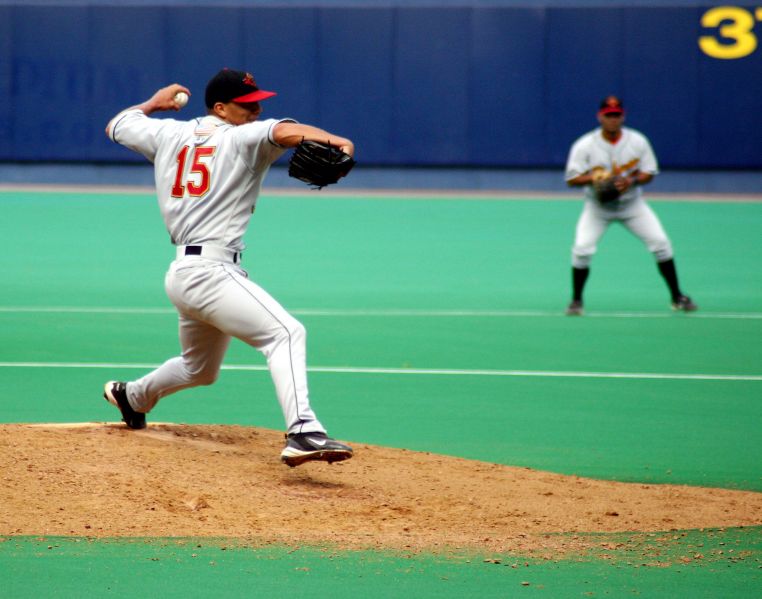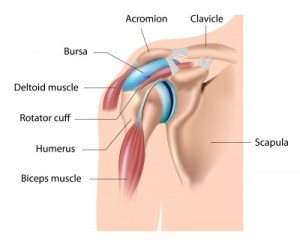Reduce Throwing Injuries Through Proper Training

Tips To Reduce Throwing Injuries
- Warm up with short tossing and advance to long tossing every time you plan to throw.
- Respect a pitch count that is appropriate for the age and skill level of the pitcher.
- “Don’t throw a curveball until you can shave!”
- Always attempt to get the lead shoulder aligned with the target.
- Condition well. Fatigue leads to poor body and throwing mechanics.
Effective pitching combines proper technique and specific training. Without these, a player performs poorly and may experience a throwing injury. Throwing a ball “over-hand” accurately and with force requires the proper body mechanics and every part of the body. This motion puts incredible stress upon the elbow and shoulder, so if the mechanics are not proper or if the body is not well conditioned an injury can occur.
Players can reduce the likelihood of throwing injuries through proper stretching and strengthening of the entire body. An effective training program prepares the various muscle groups to handle the stress of motions required in pitching. Each of these exercises can help improve performance and decrease injury.
Shoulder Joint Training
The shoulder joint musculature must be trained properly to be able to handle the stress and strain that is placed on the different muscles during the throwing motion.
 A quick overview of how the shoulder works demonstrates why proper conditioning and training is so essential. The shoulder joint is comprised of three bones, scapulae, clavicle and humerus. The head of the humerus rests on the Glenoid fossa of the scapula where it articulates when the muscles of the shoulder contract to move the arm. The head is held “against” the glenoid surface via the four Rotator Cuff (RTC) muscles, which act in unison and form a force couple when the arm is moved.
A quick overview of how the shoulder works demonstrates why proper conditioning and training is so essential. The shoulder joint is comprised of three bones, scapulae, clavicle and humerus. The head of the humerus rests on the Glenoid fossa of the scapula where it articulates when the muscles of the shoulder contract to move the arm. The head is held “against” the glenoid surface via the four Rotator Cuff (RTC) muscles, which act in unison and form a force couple when the arm is moved.
If the head is not maintained in the center of the fossa, there can be damage to the joint instantly or over a period of time. The repetitive nature of throwing usually causes injuries to the joint over time. The speed at which the humeral head rotates during the throwing motion can be as great as 7000 degrees per second. If the musculature is not trained properly, damage to the joint can occur if the overhand throwing motion is performed too often.
The scapulae is stabilized by a group of muscles referred to as the scapulae stabilizing muscles. These muscles must be strengthened and properly trained to control the scapulae movement. The scapulae act as an anchoring base for the Rotator Cuff muscles. In order for them to be able to contract and generate the force that is needed to be applied to the humeral head when it is moving during the throwing motion the RTC muscles must be able to contract against a solid, stationary object. If the scapulae stabilizing muscles are well trained, they provide the force to hold the scapulae steady.
Shoulder exercises: Seated rows, Bent over rows, Horizontal adduction/scapular retraction with Theraband, Lat pull downs into the chest, prone “Superman” series (“T’s”, “Y’s”, and “I’s”).
Anterior Chest Strengthening
A player generates arm speed during the motion of throwing of ball through the anterior chest wall musculature and Internal rotators act primarily concentrically. These muscles do not experience the same stress and are less likely to be injured in most throwing athletes.
Anterior chest exercises: Bench press, Flies, Bicep curls, straight arm flexion, abduction and scaption, Bench press with a plus (Serratus Anterior), Internal Rotation with Theraband (elbow against torso and at 90 degrees of abduction).
Posterior RTC Muscles Strengthening
After the pitch, the posterior RTC muscles decelerate the speed of rotation of the Humeral head by contracting eccentrically. Slowing the force of motion creates incredible stress and makes this muscle group extremely vulnerable to injury without proper training and technique. Effective training must include a significant amount of eccentric “loading” to generate the force needed to control the Humeral head, otherwise the player may suffer injury.
Posterior RTC Muscle exercises: External rotation with Theraband (elbow against torso and at 90 degrees of abduction) Prone weight drop, side lying external rotation, Reverse flies, Emphasis must be on the eccentric loading when the band recoils or the weight moves with gravity’s force.
Elbow Mechanics and Training
The injuries sustained by the elbow are almost always a result of poor throwing mechanics, throwing too often, or throwing the wrong pitch too often. If the thrower does not have their lead shoulder facing the target when they begin the acceleration phase of a throw, their movement forward will place extra stress on the medial aspect of the elbow joint. Young pitchers who attempt to throw too many pitches at one time or throw too many curve balls (one is too many) can injure their developing elbow.
Elbow exercises: Squeeze a stress ball, wrist curls into flexion and extension, resisted supination/pronation, wrist rolls, rubberband finger extension, “Rice” dig.
Lower Body Strengthening
The lower extremities and core musculature generate most of the “power” needed to throw a ball with great velocity. By strengthening these muscle groups players can generate more power.
Core – The core must be trained in a linear and rotational manner to mimic the actions that will occur when a ball is thrown.
Single leg strengthening – Exercises should be performed to prepare the legs for the amount of force that they will experience when the ball is thrown. Each leg will be independently supporting all of the body’s weight at some point in the throwing motion.
Hip mobility – Adequate internal rotation of the hip on the side of the body that is throwing the ball (Right handed = Right hip) must be available, or the thrower will not be able to rotate the lead shoulder far enough to get it aligned with the target.
Suggested exercises: Squats, lunges, leg press, hamstring curls, planks, side planks, medicine ball chop, torso rotations in a single plane, Theraball planks, Theraball hamstring curls.
Throwing a ball “over-hand” accurately and with force requires the involvement of the entire body. Proper body mechanics and training can help prevent injuries to the throwing athlete’s body .

























